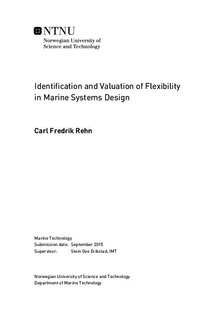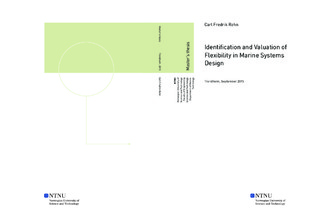| dc.description.abstract | Marine systems, typically related to transport services and offshore petroleum projects, are often complex and involve a high degree of uncertainty related to their future operating context. Uncertain factors, such as oil prices and changing environmental regulations, are usually highly influential for the performance of these projects and introduce risks for investors in the capital-intensive maritime industry.
This thesis investigates how flexibility can be considered at the design stage for handling uncertainty for marine systems, in contrast to traditional post-design operational methods. Flexibility opens up for both reducing the downside risk and taking advantage of upside possibilities, hence increasing the expected value of a design. Even though real options analysis represents an established approach for analysing flexibility, it may be inappropriate for more complex systems. To better structure options for marine systems design, a differentiation is made between more traditional, operational "on" options, and more complex, technical "in" options. Choosing the right method for analysis is ambiguous, therefore multiple approaches for identifying and valuing relevant flexibilities are discussed in this thesis. Identification methods include interviews and different systems engineering platforms for exploring how designs respond to changing contextual parameters. Valuation approaches include traditional analytical, lattice and Monte Carlo simulation methods for pricing real options, and more novel tradespace evaluation techniques.
A generic framework for flexibility analysis is presented, serving as a stepwise approach to quantifying flexibility and as a means of communication between analysts and decision makers, both technical and non-technical. The flexibility analysis framework is illustrated through a case study of a large container ship design. By using screening methods to identify candidate flexibilities such as capacity expansion and fuel-switching, and Monte Carlo simulations for valuation, it was found that flexibility increases the profitability index by 27%, on a 200 million dollar investment. Furthermore, it was demonstrated that screening and simulation methods are appropriate for the use in design of large commercial deep-sea marine transportation systems.
From an established real options valuation side, it is obvious that strategic flexibility has value, however, for non-standard applications typically involving complex "in" options, it is more ambiguous how to proceed. Even though system analysts recognise the value of flexibility, there is still a need for further research since flexibility rarely is seen in the maritime industry. | |

